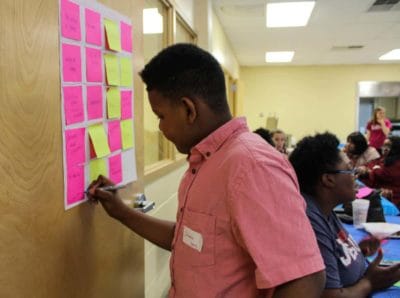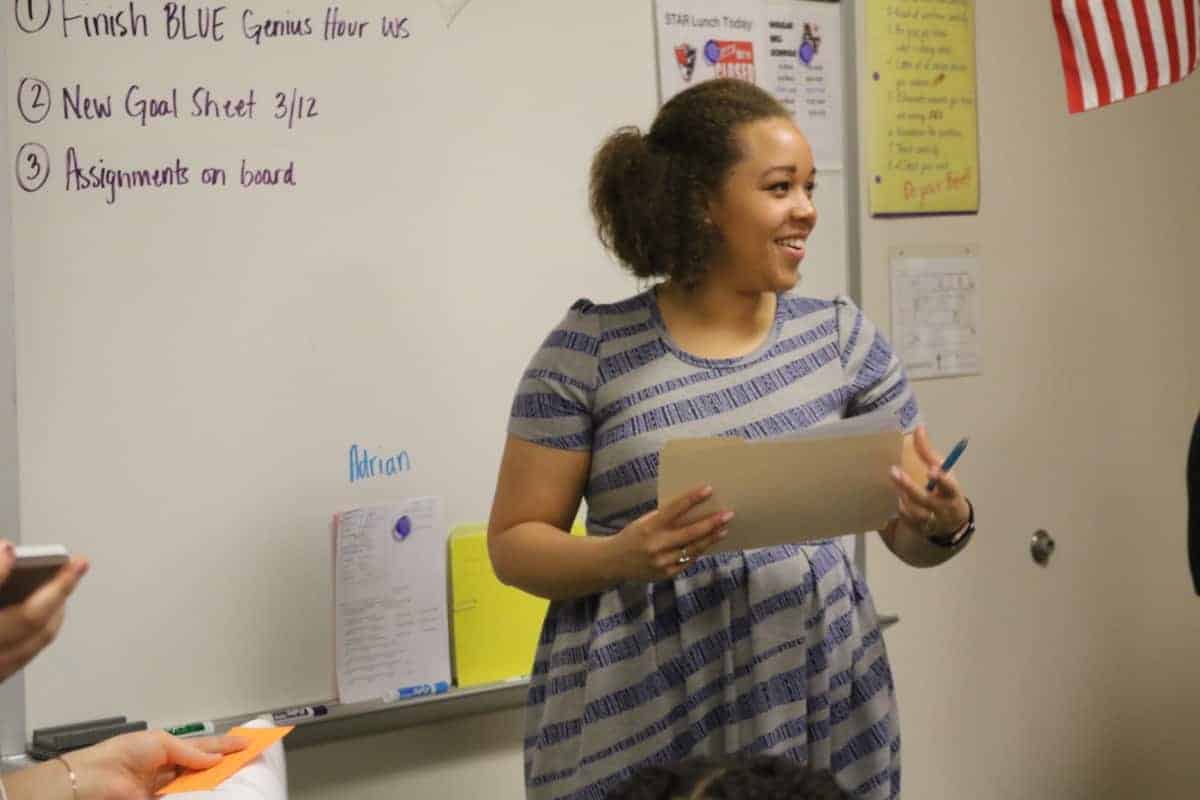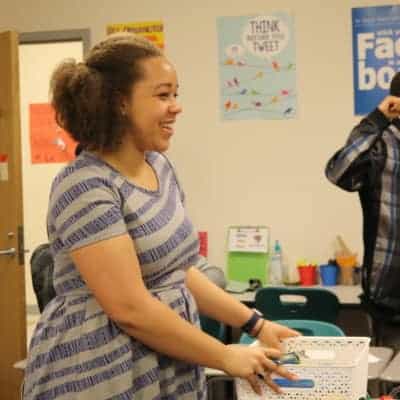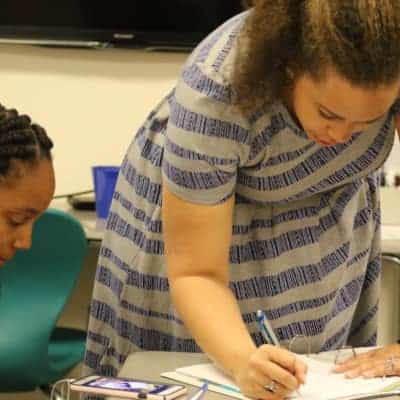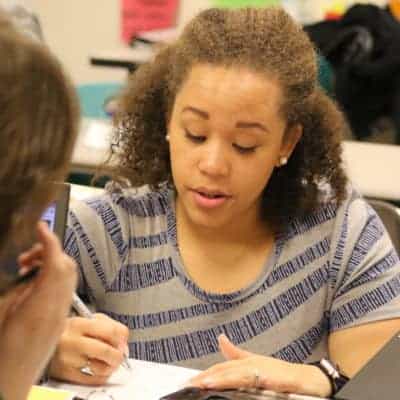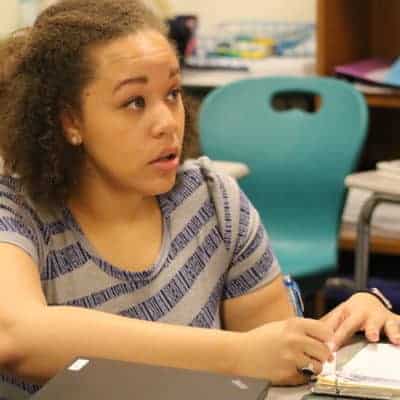It did not take many days into Jason Terrell’s teaching career for him to realize this job would be about more than the middle school English lessons he planned.
In 2012, Terrell, a fresh-out-of-college novice, came to James Martin Middle School in Charlotte through Teach For America. He became interested in teaching late in his time at Furman University. After an uncomfortable conversation with his parents, a few months later, he was instructing a classroom of eighth graders.
In addition to teaching, he helped with the football team and agreed to lead the baseball team. But far more of his coaching happened off the field, in conversations about bullying, suicide, and parents in prison.
We are sitting in a west Charlotte corner market, at a small table in the sun, on a warm fall afternoon. Music blares from overhead speakers, frenetically hopping genres: funk to grunge to the theme song from Goldfinger. People come and go with their sandwiches and six packs. Terrell has a notebook on the table in front of him, although he does not refer to it. I lean in to hear what he has to say—it is clear he has told this story before.
“I had students I didn’t even know who would come to my classroom and stand outside my door to talk to me,” Terrell recalls, “because they didn’t see another male who looked like them in the school building.”
Terrell, who is black, was a rare find.
Despite a rapidly diversifying student body, teachers in North Carolina schools are disproportionately white. In the 2016-17 school year, 80 percent of North Carolina’s roughly 94,000 public school teachers were white. That proportion far outpaces the ratio of white students—just less than half of the 1.4 million-person student body.
Although black children make up a quarter of all public school students in North Carolina, black teachers comprise just 14 percent of teachers. Latinos are underrepresented, too, even as North Carolina’s Latinx population surges. The Department of Public Instruction reports just 4.9 percent of the state’s teachers are a race other than white or black; Latinx students make up 17 percent of public school enrollment.
The lack of teachers of color in this state mirrors a national trend—the number of black teachers in the U.S. plunged after desegregation, when all-black schools closed and predominantly white school districts refused to hire black teachers for their newly-integrated classrooms. In recent decades, those numbers have rebounded, but not on pace with the so-called browning of America. It is a problem that is complicated and difficult to triage, although the risks of leaving the imbalance as it is today are too great for policymakers and educators to ignore.
“A lot of my boys would come to me, especially the African-American students, almost like a father figure,” Terrell says. “And I was 21 years old at the time.
“I almost needed my own father figure.”
North Carolina is not the only state grappling with racial imbalance in the classroom.
Studies repeatedly point out the disparity between the proportion of students of color and their racial representation among teachers. “A gap persists between the percentage of minority students and the percentage of minority teachers in the United States school system,” write the authors of a September 2017 Learning Policy Institute report.
“States have not been doing nearly enough to increase the diversity of their teaching ranks,” the Center for American Progress (CAP), a liberal think tank, says in a 2014 analysis. Last fall, the group noted “marginal increases” in the percentages of teachers of color nationwide, from 12 percent of all teachers in 1987 to 17 percent in 2012.
CAP gave North Carolina a diversity index of 31—signifying the percentage point gap between the ratio of non-white students and teachers in the state.
The gap is of particular concern among Latinx educators, given the rapid growth in North Carolina’s Latinx population. The state was home to 75,000 people who identified as Latinx in 1990—and roughly a million today. The Latinx population in North Carolina surged 16.5 percent between 2010 and 2016, according to the Census Bureau. And yet, as the NC Department of Public Instruction data show, Latinx teachers make up a very small percentage of the state’s teaching workforce. “One of the challenges I see is that sometimes we may be seen as less professional,” says America Moreno Jimenez, a Mexican immigrant who teaches ESL at a Raleigh high school. “Our actions and our choices are different based on our experiences and our cultures. That doesn’t necessarily mean we are less professional. It just means we approach things in a different manner.”
She says she is one of about four Latinx educators in her school, where student diversity outpaces educator diversity. “That is better than my own high school where we did not have any Latinx teachers,” she says, referring to her public school education in Hendersonville.
Like many teachers of color, Jimenez often finds herself in less-than-comfortable situations as she translates culture for her white colleagues.
“Often times we are asked to step in as the ‘Latinx teacher'” she says, to connect with specific students or offer explanation to confused colleagues who do not understand a particular aspect of Latinx culture. “There’s not enough of us to go around.”
That sentiment is familiar to other teachers of color across the state.
“My greatest struggle as a teacher of color in North Carolina is simply finding other educators of color to connect with in meaningful ways,” says Christina Cole Spears, a third-year special education teacher in Apex. “It’s difficult to explain the feeling of walking into a school building where the vast majority of people of color are transportation or custodial staff.”
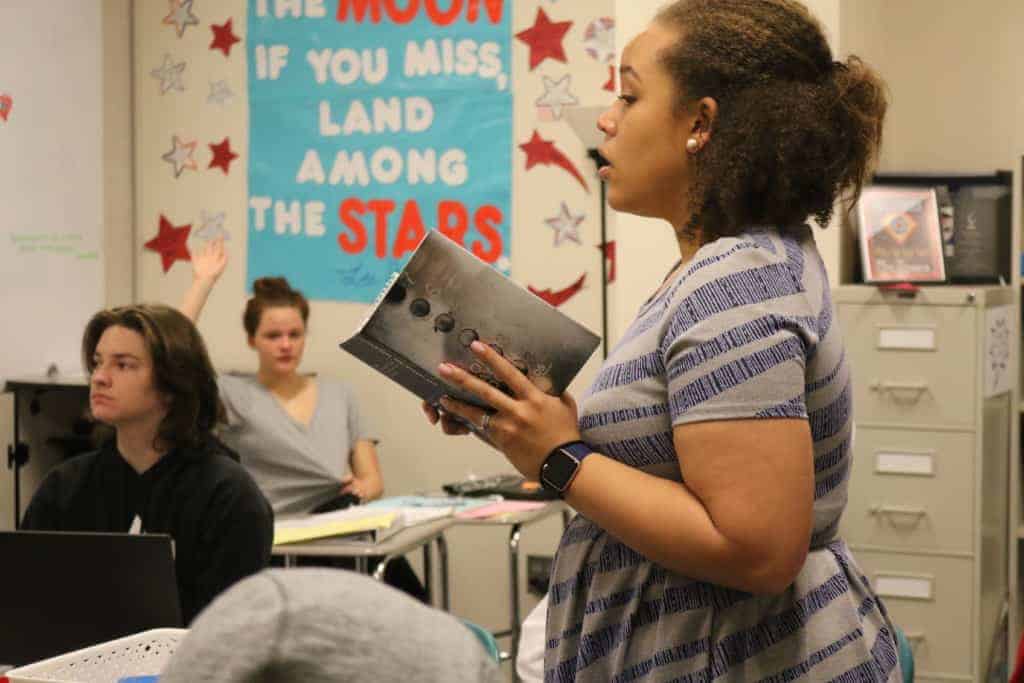
That affects her every day, she says, especially as it relates to the way she interacts with students.
“I want my students to feel seen and loved, especially when the majority of their peers and teachers are white,” she says. “Because of my personal experience, I understand the impact of witnessing a black woman lead a class.
“My black students see themselves reflected in me.”
The benefits black students incur from exposure to just one black teacher are striking—and directly applicable to North Carolina.
A large study published in the spring of 2017 looked at 100,000 black North Carolina elementary school students. Having just one black teacher in third, fourth or fifth grades reduced the likelihood that black males from low-income households would drop out of school by 39 percent.
By high school, black male and female students—exposed to just one black teacher in elementary school—were more likely to go to college than their peers who had all white teachers.
“Our findings suggest that stubbornly persistent attainment gaps are not impervious to policy changes,” the study’s authors write. (Interestingly, however, they also note that the dosage effect of exposure to multiple black teachers had a “marginal” and “relatively small” effect on students’ long-term outcomes.)
There are short-term benefits to exposure to same-race teachers, too, including lower suspension rates, less absenteeism, and improved standardized test scores.
A study published last year, which also focused on North Carolina students, found “consistent evidence that exposure to same-race teachers is associated with reduced rates of exclusionary discipline for black students.” That finding held for male and female students, from all economic backgrounds and at all grade levels.
Researchers who studied the effects of same-race teachers say the conclusions are striking. “Right now it’s reasonable to say that white students have some sort of advantage because they are more likely to encounter teachers who look like them,” says Brian Kisida, a professor at the University of Missouri who has written about this issue along with a colleague at N.C. State, Anna Egalite.
“We tried to get at what’s driving the effect,” Kisida said.
There are three ways in which researchers believe teachers of color positively influence students of color in the classroom. First, he says, the mere presence of a black male, for example, in a position of authority, presents a role model figure to black male students. Seeing that role model every day could change a student’s outlook for his future.
Researchers have also looked at teachers of color and the Pygmalion effect—the correlation between a teacher’s expectations of a student and that student’s future academic outcomes. School districts across the country have spent hours and dollars in recent years on implicit bias training for their teachers, but a study published last fall suggests white teachers consistently have lower academic expectations for black students than they do for white ones. A 2016 study reached a similar conclusion.
Finally, Kisida says, teachers of color may be particularly better suited to communicate and confer with students of color, something he calls cultural translation, that makes it easier to connect the curriculum in a way that resonates with students.
Christina Spears, the Apex special education teacher, told me the rapport she develops with students happens quickly—black students call her “mama”—and because of a shared understanding. “I’m not old enough to be anybody’s mama,” she says, “but it happens because of the way we talk, the inside jokes and cultural references, and even more so the way we may view education.
“Yet again, it addresses the need for educators of color in classrooms with students.”
Recruiting and retaining more teachers of color would not negatively affect white students, either, Kisida says. “We don’t have to choose. We can have both.”
Importantly, Kisida says researchers do not intend for black students, for example, to only be taught by teachers of their same race. The dosage effects highlighted in the North Carolina research indicate exposure to the first black teacher has a significant effect on the outcomes for black students.
“We’re not trying to necessarily flip it the other direction,” Kisida says. “It’s not an argument for segregated schools. It’s an argument for representation.”
Within his school, Jason Terrell found himself playing a unique role.
“Men of color are often placed in situations where they have to manage bodies and not teach content,” he says. “They’re expected to be the disciplinarians in your school, they’re expected to be the enforcers.”
In his first year of teaching middle school, Terrell struggled. “There’s no training about how to be an effective role model; there’s no leadership development around that,” he says. “It was challenging to be in a space where there weren’t that many men—or people in general—that I could come to and talk to about my experience.”
He turned to a veteran male teacher in his school, using the older colleague as a mentor. They met frequently, talked out problems, and strategized about ways to help their students. That relationship, Terrell says, made him realize there was a void—few male teachers of color, and even fewer resources to support them.
Starting in 2014, Terrell and his Teach For America colleague, Mario Shaw, started hosting casual dinners in their own apartments for other male teachers of color. The gatherings were small at first—three people at this one, five at the next. “We didn’t have any intentions of doing a program,” Terrell says. “We didn’t have a name. It was just a group of us texting in a group chat.”
Eventually, though, the dinners sparked an idea.
Terrell and Shaw decided to quit teaching and launch Profound Gentlemen, a Charlotte-based nonprofit that aims to create a network of male teachers of color who can have a positive effect on boys of color. The move was risky. “I’d never run a nonprofit. Never even worked at a nonprofit,” Terrell says with a laugh.
But he knew, from his own experience attending Title I schools as a boy and then teaching boys of color in Charlotte, that a program such as Profound Gentlemen was long overdue.
The organization would use a peer-to-peer mentorship model, they decided, pairing teachers with what they call “impact leaders.” Programming would focus on developing participants into effective teachers, coaching on how to be a role model and discussions about race and community justice.
Today, Profound Gentlemen serves about 200 teachers, about half of which live in North Carolina, including in Mecklenburg, Wake, Pitt, Halifax, and Nash counties. It hosts in-person quarterly trainings for its members in five cities: Atlanta, Charlotte, Chicago, Memphis and Washington, plus virtual sessions for teachers who live elsewhere. There is an annual conference in Charlotte. Each teacher who participates in Profound Gentlemen agrees to commit to 20 hours of one-on-one coaching each year with his impact leader.
All of that, Terrell emphasizes, points toward one goal: improving the outcomes for boys of color.
As with other issues in public education, at least part of the solution to improving teacher diversity is buried within the teacher pipeline. Policymakers nationwide have offered little in the way of wholesale solutions.
Much of the attention has focused on recruitment, particularly of teachers of color to high-poverty, urban schools that tend to serve students of color at higher rates than suburban ones. “Efforts over recent years to recruit more minority teachers and place them in schools serving disadvantaged and minority student populations have been very successful,” the Learning Policy Institute report says. “This has been somewhat of an unheralded victory.”
Those efforts, teachers of color agree, should continue. Spears suggests a focus on non-traditional pathways such as a lateral entry and Teach For America, coupled with teacher cadet programs in high school that could awaken students of color to possibilities in teaching.
The typical teacher pipeline solutions often come up, too: More scholarship initiatives such as the North Carolina Teaching Fellows program, more intentional pathways to professional growth, and incentivized pay for teaching in hard-to-staff subjects and schools.
Two decades ago, Florida’s legislature created the Florida Fund for Minority Teachers, which uses tuition grants of up to $4,000 annually to support diverse education majors at the state’s public and private universities. New York City launched NYC Men Teach, which is on track to add 1,000 male educators of color over the next three years. In North Carolina, individual school districts pursue their own teacher diversity hiring strategies. Charlotte-Mecklenburg Schools, for example, targeted career fairs in Florida to increase its ranks of Latinx educators.
Hiring more teachers of color is not the sole solution. In a report released last year by the Learning Policy Institute, researchers argue the U.S. education system has focused on the wrong part of the pipeline.
“Underlying most of the commentary and policy on this issue has been the assumption, largely untested, that minority teacher staffing problems are rooted in the front end of the teacher supply pipeline,” the authors write. There has been far less attention paid to the back end of the pipeline: retention.
Between 1987 and 2012, the number of teachers of color in the United States doubled. (The number of white teachers increased, too, so the proportions as related to the student body did not grow at the same rate.) But over the same period of time, turnover rates among teachers of color were “significantly higher” than those among white teachers, the LPI report says. Surveys of teachers who quit indicated a strong correlation between their departures and “organizational and working conditions.” In 2012-13, nationwide, turnover among teachers of color was 25 percent higher than that of white teachers.
In Illinois, lawmakers created the Grow Your Own Teachers initiative, which combines a recruitment strategy with two years of mentoring support. Boston Public Schools came up with a teaching fellowship that includes mentoring and has received praise for its effectiveness.
But in North Carolina, teachers of color are often left to their own devices. Some turn to Twitter, where they collaborate with peers—from the state and elsewhere—to solve common challenges.
Terrell says that reality is part of what makes Profound Gentlemen’s programming so vital to its members. “Recruitment is sexy,” he says. “But it’s gotta be more than that. Everyone wants teachers in, but there aren’t initiatives to keep them in.”
Even when school systems successfully recruit and retain teachers of color, those educators often meet institutional racism and implicit bias.
Spears recalls participating in a school equity team meeting “where some marginalized groups, and thus their voices, are missing from the conversation.” She is working to change those attitudes—by mentoring students, advising the step team, and pushing her institutions (and their leaders) to change. “Although it’s not my sole responsibility or the responsibility of teachers in color in general, I feel it’s necessary to use our pedagogy to focus on social justice issues,” she says. “It may be difficult for white educators to engage in these types of conversations with colleagues and peers, but it should be the heart of our everyday work.”
Similarly, Profound Gentlemen’s founders want to see more institutional change. They met with school systems about their hiring practices, encouraging schools to think of male educators—and particularly men of color—as more than disciplinarians but, as, Terrell puts it, “someone kids can come to for nurturing and to learn from.” In a session with hiring managers in Charlotte, he says, heads nodded as attendees realized they had not considered their implicit biases in this way.
As we talk, in the west Charlotte deli, Terrell reflects on the basic goal of education in the 21st century, the idea that we are trying to set kids up to have a better future. He acknowledges the public policy side of teacher diversity is somewhat of an enigma—no silver bullet, the most obvious solutions often the most expensive and politically challenging. Regardless, he says, Profound Gentlemen’s work matters. It is making a difference, one teacher, one classroom at a time. He looks up, wants to make sure I get this point.
“Kids need to see different images of success,” he says, “that reflect our communities.”
Recommended reading
